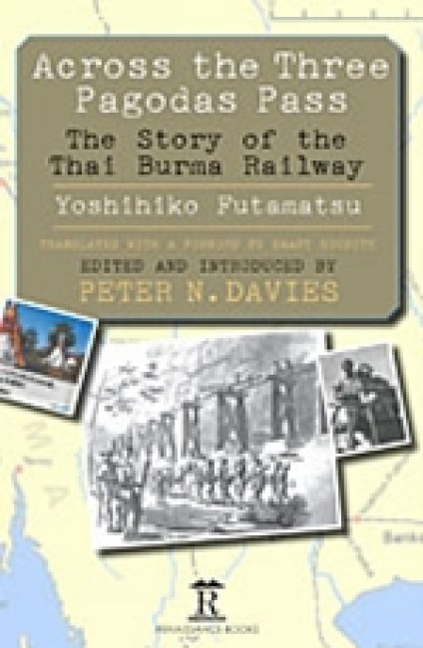Book contents
- Frontmatter
- Dedication
- Contents
- Acknowledgements
- Foreword
- Introduction
- Across the Three Pagodas Pass
- Translator’s Acknowledgements
- Preface
- Chapter 1 Departure for the Front
- Chapter 2 In Indo-China
- Chapter 3 Opening of Hostilities
- Chapter 4 The River Krian
- Chapter 5 The Malayan Campaign
- Chapter 6 The Fall of Singapore
- Chapter 7 Surrender
- Chapter 8 Shōnan: Light of the South
- Chapter 9 The Thai-Burma Railway
- Chapter 10 Preparing Construction
- Chapter 11 Banpong
- Chapter 12 Prisoners-of-War
- Chapter 13 Constructing the Railway
- Chapter 14 Thailand
- Chapter 15 The River Kwae Noi
- Chapter 16 The Mae Khlaung Bridge
- Chapter 17 Kanchanaburi
- Chapter 18 The Jungle
- Chapter 19 From Bangkok to Singapore
- Chapter 20 Rush Construction
- Chapter 21 The Base at Wanyai
- Chapter 22 The Labour Force
- Chapter 23 Survey Unit
- Chapter 24 Test Run
- Chapter 25 Bridge-Building and Shifting Earth
- Chapter 26 The Rainy Season: The Monsoon
- Chapter 27 Kinsaiyok
- Chapter 28 Diseases and Epidemics
- Chapter 29 Cattle Drive
- Chapter 30 Living in the Jungle
- Chapter 31 Soon to the Three Pagodas Pass
- Chapter 32 Towards the Setting Sun
- Chapter 33 Opening to Traffic
- Chapter 34 The Bombing
- Chapter 35 End of the War
- Chapter 36 Internment
- Chapter 37 Repatriation
- Footnote
- Postscript
- End Notes
- Glossary
- Bibliography
- Index
Chapter 19 - From Bangkok to Singapore
Published online by Cambridge University Press: 13 May 2022
- Frontmatter
- Dedication
- Contents
- Acknowledgements
- Foreword
- Introduction
- Across the Three Pagodas Pass
- Translator’s Acknowledgements
- Preface
- Chapter 1 Departure for the Front
- Chapter 2 In Indo-China
- Chapter 3 Opening of Hostilities
- Chapter 4 The River Krian
- Chapter 5 The Malayan Campaign
- Chapter 6 The Fall of Singapore
- Chapter 7 Surrender
- Chapter 8 Shōnan: Light of the South
- Chapter 9 The Thai-Burma Railway
- Chapter 10 Preparing Construction
- Chapter 11 Banpong
- Chapter 12 Prisoners-of-War
- Chapter 13 Constructing the Railway
- Chapter 14 Thailand
- Chapter 15 The River Kwae Noi
- Chapter 16 The Mae Khlaung Bridge
- Chapter 17 Kanchanaburi
- Chapter 18 The Jungle
- Chapter 19 From Bangkok to Singapore
- Chapter 20 Rush Construction
- Chapter 21 The Base at Wanyai
- Chapter 22 The Labour Force
- Chapter 23 Survey Unit
- Chapter 24 Test Run
- Chapter 25 Bridge-Building and Shifting Earth
- Chapter 26 The Rainy Season: The Monsoon
- Chapter 27 Kinsaiyok
- Chapter 28 Diseases and Epidemics
- Chapter 29 Cattle Drive
- Chapter 30 Living in the Jungle
- Chapter 31 Soon to the Three Pagodas Pass
- Chapter 32 Towards the Setting Sun
- Chapter 33 Opening to Traffic
- Chapter 34 The Bombing
- Chapter 35 End of the War
- Chapter 36 Internment
- Chapter 37 Repatriation
- Footnote
- Postscript
- End Notes
- Glossary
- Bibliography
- Index
Summary
On 1 October 1942 work started on the Mae Khlaung steel bridge. The foundations of the bridge-piers were laid as concreted well-cribs, and for excavating the hard, tough river-bottom apparatus was needed, apparatus called a Gatmel dredger. Under water on the river-bottom the sharp edges of its blades bored into and pulled up the foundation, the edges of the bades closed up, bored into the earth and sand, gripped the load and carried it up: such was its mechanism. But at the time a Gatmel could not be found in Thailand. On 1 November I was specially assigned by 9 Railway Regiment HQ to search for one. The official order ran, ‘Railway Official Futamatsu to go on a business trip to Malaya and Singapore to collect under-water dredging apparatus. Sjt Nagata and Superior Private Yasawa to be attached to him.’ That term ‘to be attached’ meant that regular soldiers must cooperate with a gunzoku without supervision. ‘Attached’ to me were Sjt Nagata in charge of machine parts and Superior Private Yasawa as orderly. Out party left for Malaya, leaving Sakamoto Unit at Wanyai.
When we got to Banpong we found the Southern Thai National Line was impassable to the East of Nakhon Chaisiri on account of flooding of the River Menam. We stood by waiting for two or three days until a steamer became available for Bangkok from Nakhon Chaisiri, so we got to Bangkok despite being unable to go by train directly to it. All you could see was what looked like a lake and of course the railway line was under water. In the South Thailand plain here and there you could see coconut palms and the roofs of houses apparently floating on the water. The wide surface of the muddy water at the peak of these hot days glittered in the sunlight, and ripples gathered over the railway line embankment. At a wharf near the station a small roofed steamer was waiting for people arriving by train. Women farm-workers carrying vegetables, business-like Chinese, yellow-robed bonzes and so on, a miscellany of common people crowded onto the upper deck of the ship which quivered and shook as it moved away from the wharf.
- Type
- Chapter
- Information
- Across the Three Pagodas PassThe Story of the Thai-Burma Railway, pp. 89 - 93Publisher: Amsterdam University PressPrint publication year: 2013

